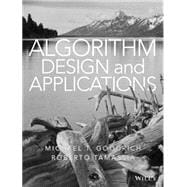“This is a wonderful book, covering both classical and contemporary topics in algorithms. I look forward to trying it out in my algorithms class. I especially like the diversity in topics and difficulty of the problems.”
ROBERT TARJAN, PRINCETON UNIVERSITY
“The clarity of explanation is excellent. I like the inclusion of the three types of exercises very much.”
MING-YANG KAO, NORTHWESTERN UNIVERSITY
“Goodrich and Tamassia have designed a book that is both remarkably comprehensive in its coverage and innovative in its approach. Their emphasis on motivation and applications, throughout the text as well as in the many exercises, provides a book well-designed for the boom in students from all areas of study who want to learn about computing. The book contains more than one could hope to cover in a semester course, giving instructors a great deal of flexibility and students a reference that they will turn to well after their class is over.”
MICHAEL MITZENMACHER, HARVARD UNIVERSITY
“I highly recommend this accessible roadmap to the world of algorithm design. The authors provide motivating examples of problems faced in the real world and guide the reader to develop workable solutions, with a number of challenging exercises to promote deeper understanding.”
JEFFREY S. VITTER, UNIVERSITY OF KANSAS
DidYouKnow?
This book is available as a Wiley E-Text.
The Wiley E-Text is a complete digital version of the text that makes time spent studying more efficient. Course materials can be accessed on a desktop, laptop, or mobile device—so that learning can take place anytime, anywhere.
A more affordable alternative to traditional print, the Wiley E-Text creates a flexible user experience:
- Access on-the-go
- Search across content
- Highlight and take notes
- Save money!
The Wiley E-Text can be purchased in the following ways:
Via your campus bookstore:
Wiley E-Text: Powered by VitalSource®
ISBN 9781119028796
*Instructors: This ISBN is needed when placing an order.
Directly from:
www.wiley.com/college/goodrich








